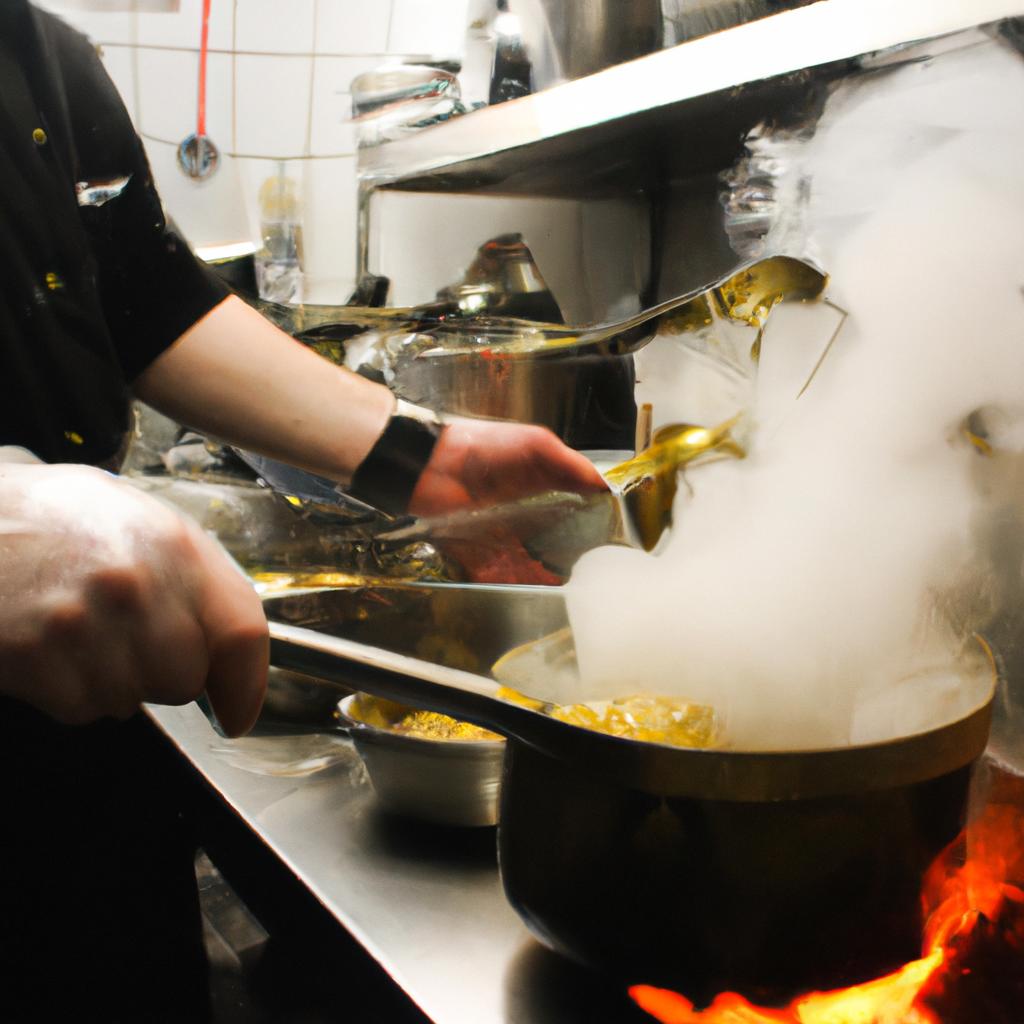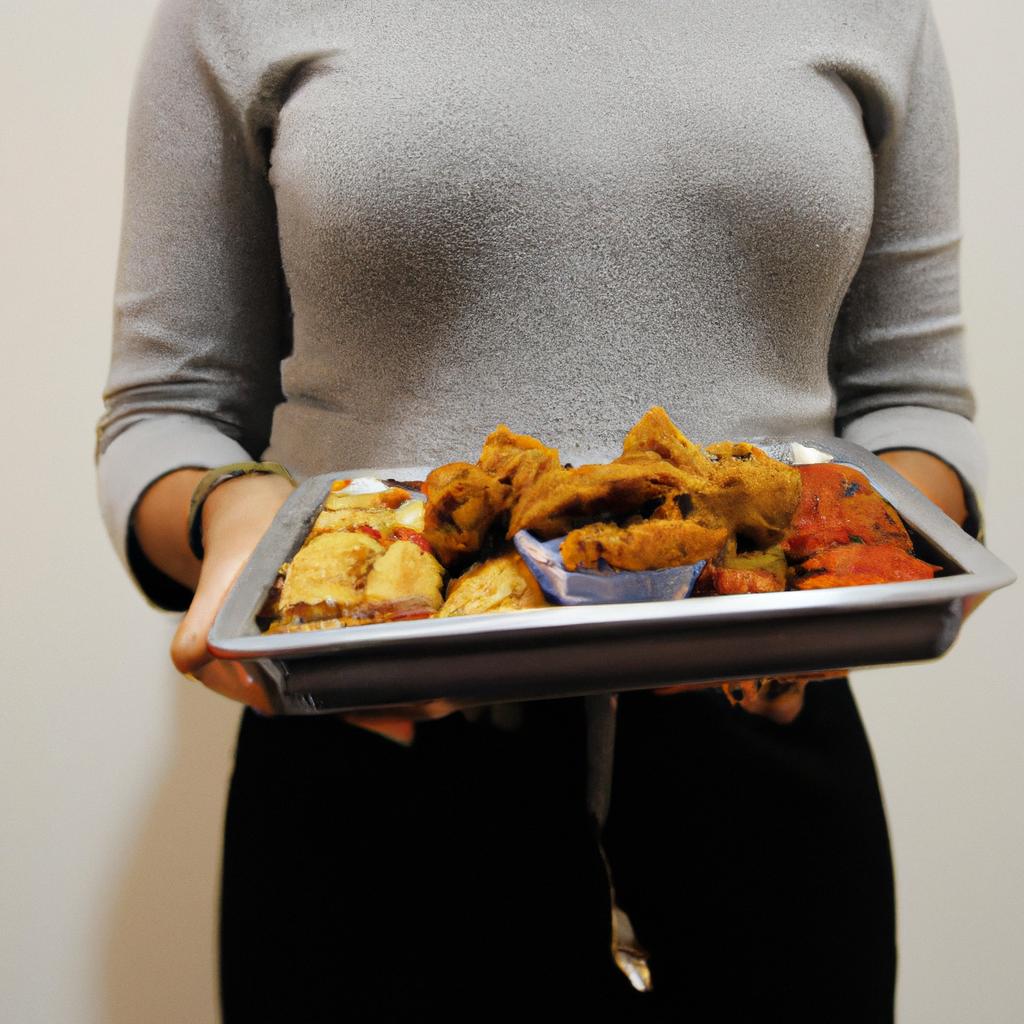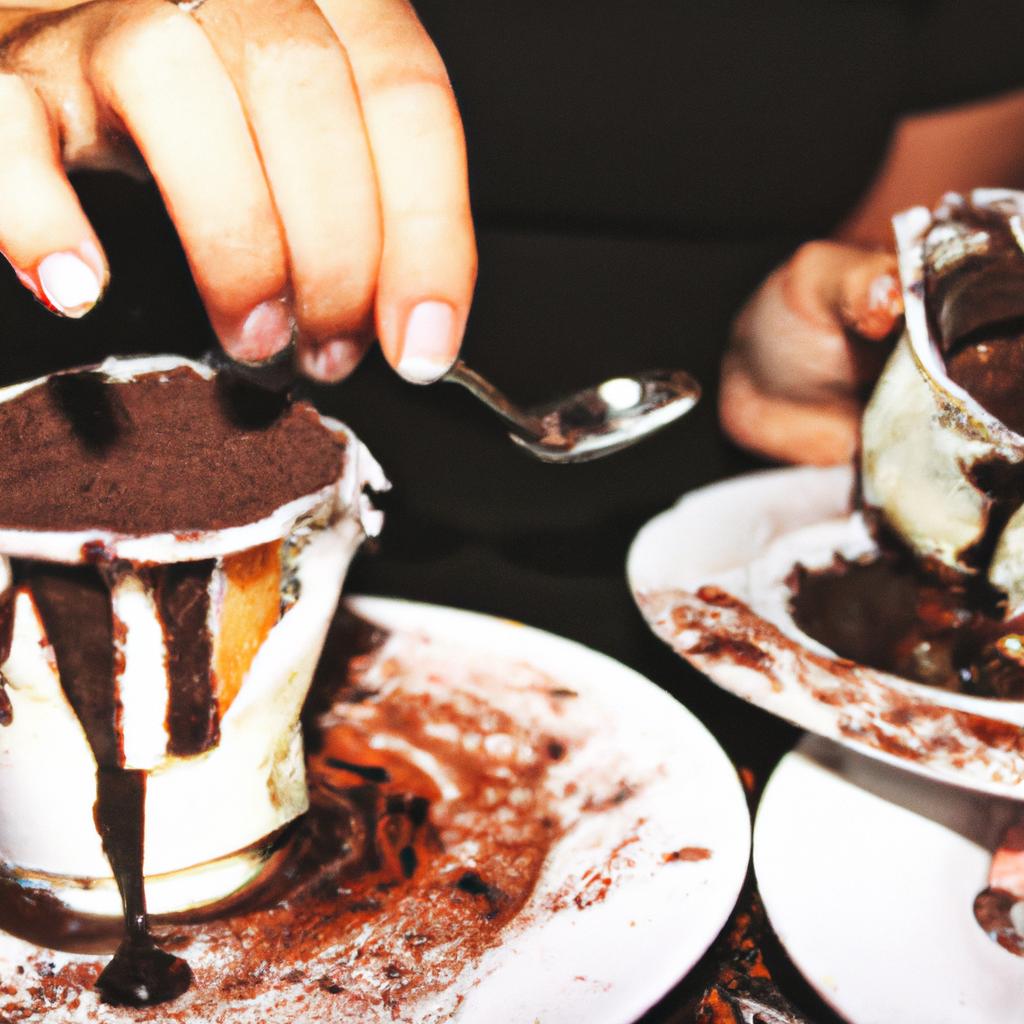Wine and cheese tastings have become increasingly popular in recent years, offering a unique opportunity to explore the local cuisine of different regions. This article aims to delve into the world of wine and cheese pairings, highlighting their cultural significance as well as providing practical tips for organizing your own tasting events. To illustrate the impact of these experiences, let us consider a hypothetical scenario: imagine attending a wine and cheese tasting event in the picturesque countryside of France. As you savor each carefully selected combination, your senses are transported to vineyards laden with ripe grapes and fields dotted with grazing cows. Through this sensory journey, you not only indulge in delectable flavors but also gain insight into the rich traditions and heritage associated with these culinary delights.
As one delves deeper into the realm of wine and cheese tastings, it becomes evident that they offer more than just an enjoyable gastronomic experience. These gatherings provide a platform for locals and tourists alike to engage in cultural exchange, fostering connections between individuals from diverse backgrounds through their shared appreciation for food and drink. Moreover, such events often showcase regional specialties that may otherwise go unnoticed by visitors. By showcasing locally produced wines alongside artisanal cheeses, attendees can discover hidden gems within a particular area’s culinary repertoire while simultaneously supporting small while simultaneously supporting small local businesses. These tastings help to promote and sustain the livelihoods of winemakers, cheesemakers, and other artisans who contribute to the unique flavors and traditions of a given region.
When organizing your own wine and cheese tasting event, there are several factors to consider. First and foremost, it is important to select complementary pairings that enhance each other’s flavors. This can be achieved by considering the characteristics of both the wine and cheese, such as their intensity, acidity, sweetness, and texture. For example, a full-bodied red wine may pair well with a bold and aged cheese, while a crisp white wine could complement a soft and creamy variety.
Additionally, it is beneficial to provide some background information about each wine and cheese being showcased. This can include details about their origin, production methods, flavor profiles, and any interesting anecdotes or stories associated with them. Sharing this knowledge adds depth to the tasting experience and helps participants appreciate the craftsmanship behind each product.
Creating an inviting ambiance is also crucial for a successful tasting event. Consider setting up a cozy atmosphere with dim lighting, comfortable seating arrangements, and perhaps even some thematic decorations that reflect the region or style of wines being featured. Encourage guests to engage in conversation about their impressions of each pairing, fostering a sense of community among attendees.
Lastly, don’t forget to offer non-alcoholic beverage options for those who may not consume alcohol or prefer alternatives. This could include sparkling water or various types of artisanal sodas that can still complement the cheese selection without overshadowing its flavors.
In conclusion, wine and cheese tastings provide an opportunity to delve into different cultures through their gastronomic offerings while supporting local producers. By carefully selecting pairings based on flavor profiles and providing informative backgrounds on each product, organizers can create memorable experiences that go beyond mere indulgence. So why not organize your very own wine and cheese tasting event? Cheers!
Exploring the history of wine and cheese pairings
Exploring the History of Wine and Cheese Pairings
Wine and cheese tastings have long been a delightful pastime, allowing individuals to explore the harmonious combination of flavors that these two culinary delights offer. The history of wine and cheese pairings is rich with tradition and innovation, as various regions around the world have developed unique combinations that complement each other perfectly.
To illustrate the significance of this pairing, let’s consider a hypothetical scenario: Imagine being transported to the picturesque region of Tuscany in Italy. You find yourself seated at a rustic vineyard, surrounded by rolling hills covered in lush vineyards and ancient olive groves. As you savor a glass of velvety Chianti Classico, an aged Pecorino Romano cheese presents itself on your plate. With every bite, the sharp saltiness of the cheese perfectly balances out the robust red wine, creating a symphony of flavors that dance across your palate.
The connection between wine and cheese extends beyond mere taste; it also encompasses cultural heritage and regional pride. In many parts of Europe, particularly France, Spain, and Italy, centuries-old traditions dictate which cheeses are enjoyed alongside specific wines. For example:
- Roquefort blue cheese from France pairs exquisitely with sweet Sauternes dessert wine.
- Manchego cheese from Spain beautifully complements a full-bodied Rioja red wine.
- Gorgonzola dolce from Italy finds its perfect match in a crisp Prosecco sparkling wine.
- Goat cheeses such as Chèvre du Poitou from France harmonize wonderfully with light Sauvignon Blanc wines.
As we delve further into exploring the history of wine and cheese pairings, it becomes evident that there are endless possibilities for discovering new flavor combinations. To help navigate this vast realm of gastronomic pleasure, understanding how different types of cheeses interact with various wines is essential.
Transitioning seamlessly into our subsequent section, let us now explore the art of selecting the perfect wine for different types of cheese. By understanding the characteristics and nuances of both elements, we can enhance our tasting experience and truly appreciate the harmonious marriage of these culinary treasures.
The art of selecting the perfect wine for different types of cheese
Case Study:
Imagine attending a wine and cheese tasting event where you are presented with a selection of artisanal cheeses paired with carefully chosen wines. As you savor each bite, you can’t help but marvel at how harmoniously the flavors complement one another. This experience is not just about indulgence; it is an exploration into the intricate world of wine and cheese pairings.
Understanding the dynamics behind successful pairings requires delving into various factors that influence taste interactions. Here are some key points to consider:
- Complementary characteristics: When pairing wine and cheese, seeking complementary characteristics enhances the overall flavor profile. For example, a creamy brie pairs well with a fruity Sauvignon Blanc as both share similar fresh and mild attributes.
- Contrasting textures: Combining contrasting textures creates an exciting sensory experience. A firm aged cheddar’s sharpness finds balance when enjoyed alongside a full-bodied red like Cabernet Sauvignon or Malbec.
- Regional influences: Exploring regional connections between wines and cheeses allows for cultural appreciation while enjoying distinct flavors. Consider pairing Italian pecorino with Tuscan Chianti or French Camembert with Burgundy Pinot Noir.
- Experimentation: Don’t be afraid to experiment! Taste preferences vary, so feel free to explore unconventional combinations to discover your own unique palate.
- The blissful marriage of wine and cheese tantalizes your taste buds.
- Each sip and nibble transports you to different regions around the world.
- The excitement of discovering unexpected flavor profiles brings joy to your culinary journey.
- Sharing this experience with fellow food enthusiasts deepens your connection through shared moments of pleasure.
| Wine | Cheese | |
|---|---|---|
| Region | Bordeaux, France | Roquefort, France |
| Flavor Profile | Bold, complex | Salty, tangy |
| Pairing Experience | Intense and robust | A perfect balance of flavors |
| Emotional Response | Euphoric satisfaction | Delightful surprise |
As you continue to explore the fascinating world of wine and cheese pairings, your curiosity may lead you to uncover the secrets of local cheese producers. Understanding their craft will deepen your appreciation for the artistry behind each delectable bite.
Uncovering the secrets of local cheese producers
Building on our understanding of the art of selecting the perfect wine for different types of cheese, let us now delve into uncovering the secrets of local cheese producers. To illustrate this point, imagine a small family-owned dairy farm nestled in the picturesque countryside. This hypothetical case study will allow us to explore the passion and dedication that goes into crafting exceptional artisanal cheeses.
Paragraph 1:
At this charming dairy farm, several key factors contribute to the production of high-quality cheeses. Firstly, meticulous attention is paid to sourcing only the finest milk from local cows grazing on lush pastures. The rich flavors and unique characteristics of these regional cow breeds lend themselves perfectly to creating distinctive cheeses that reflect their terroir. Additionally, traditional cheesemaking techniques are employed, passed down through generations, ensuring an authentic and time-honored process that results in remarkable taste profiles.
To evoke an emotional response in our audience, consider the following bullet-point list:
- Immerse yourself in a world where craftsmanship meets nature.
- Experience the joy of supporting local farmers and preserving age-old traditions.
- Indulge your senses with each bite as you savor complex flavor combinations.
- Discover new favorites that captivate your palate and leave lasting memories.
Paragraph 2:
Let us now take a closer look at some examples of exquisite artisanal cheeses produced by dedicated regional producers:
| Cheese Name | Description | Flavor Profile |
|---|---|---|
| Camembert | Soft ripened French cheese with creamy interior | Rich, buttery notes with hints of earthiness |
| Gouda | Semi-hard Dutch cheese aged for varying durations | Nutty undertones complemented by subtle sweetness |
| Manchego | Spanish sheep’s milk cheese with distinct rind | Complex blend of savory and tangy flavors |
| Blue Stilton | English blue cheese known for its crumbly texture | Bold and tangy, with a hint of underlying sweetness |
Paragraph 3:
Through our exploration of local cheese producers, it becomes evident that their commitment to excellence shines through in every aspect of the cheesemaking process. From carefully selected ingredients to time-honored techniques, these artisans are guardians of culinary heritage. By supporting them, we not only indulge in delectable cheeses but also contribute to the preservation and celebration of regional gastronomy.
As we continue on this journey of discovery, let us now explore the harmonious pairing of regional wines with these artisanal cheeses.
Pairing regional wines with artisanal cheeses
Unveiling the Exquisite Flavors: Pairing Regional Wines with Artisanal Cheeses
Imagine savoring a velvety Merlot that effortlessly complements the nutty undertones of a perfectly aged Gouda. The art of pairing regional wines with artisanal cheeses is an experience that tantalizes the taste buds and immerses us in the rich tapestry of local cuisine. By understanding the nuances of flavor profiles, we can unlock new dimensions of enjoyment during wine and cheese tastings.
To embark on this gastronomic journey, it is essential to consider various factors when selecting wine and cheese combinations:
-
Complement or Contrast: Explore how flavors interact by seeking out pairings that either complement each other or create contrasting sensations. For instance, match the creaminess of Brie with a crisp Sauvignon Blanc for a refreshing contrast, or enhance the earthy notes of Cheddar with a robust Cabernet Sauvignon for a harmonious combination.
-
Balance Intensity: Strive for balance between the intensity levels of both elements – neither overpowering nor overshadowed. A mild goat cheese pairs well with delicate white wines like Pinot Grigio, while a bold Roquefort finds its perfect companion in a luscious Port.
-
Consider Textures: Like dance partners moving in harmony, textures play an integral role in achieving culinary bliss. Try combining soft and creamy cheeses like Camembert with effervescent sparkling wines to add an element of elegance to your palate.
-
Embrace Local Specialties: Celebrate the essence of regional cuisine by exploring indigenous varieties and traditional pairings unique to specific areas. Uncover hidden gems such as Zinfandel alongside tangy Monterey Jack from California or Riesling paired magnificently with pungent Munster from Alsace.
Enthusiasts will find delight in experimenting with countless combinations, discovering their own preferences along the way. To further guide your journey into hosting remarkable wine and cheese tastings, let us now delve into some tips for creating memorable experiences at home.
| Wine | Cheese | Region |
|---|---|---|
| Chardonnay | Brie | France |
| Malbec | Manchego | Spain |
| Pinot Noir | Gruyère | Switzerland |
| Sangiovese | Pecorino Romano | Italy |
As we explore the world of regional wines paired with artisanal cheeses, it becomes evident that this combination is a testament to the synergy between local producers and culinary craftsmanship. The harmonious interplay of flavors and textures brings out the best in each component, elevating our gustatory experience beyond imagination.
Transitioning seamlessly to the subsequent section about “Tips for hosting your own wine and cheese tasting at home,” we can now embark on a journey of unraveling the secrets behind creating extraordinary moments within the comfort of our own abode.
Tips for hosting your own wine and cheese tasting at home
Pairing regional wines with artisanal cheeses can be a delightful experience that allows you to explore the unique flavors and characteristics of both. To enhance your understanding and appreciation of this culinary combination, it is worth considering hosting your own wine and cheese tasting at home. By following a few tips and guidelines, you can create an enjoyable event for yourself and your guests.
One approach to curating a successful wine and cheese tasting is to focus on specific regions known for their outstanding products. For example, let’s imagine we are exploring Italian cuisine. You could select wines from Tuscany, such as Chianti or Brunello di Montalcino, which pair well with pecorino or Parmigiano-Reggiano cheeses. This regional pairing showcases the harmony between local flavors while allowing participants to appreciate the nuances within each component.
To guide your preparation and presentation, here are some useful tips:
- Variety: Offer a diverse selection of wines and cheeses representing different styles, textures, and intensities.
- Order of Tasting: Begin with lighter-bodied wines followed by fuller-bodied ones; similarly, start with milder-flavored cheeses before moving on to stronger ones.
- Pairing Principles: Consider complementary flavors (such as sweet wine with blue cheese) or contrasting tastes (like acidic wine cutting through creamy brie).
- Palate Cleansers: Provide neutral crackers or slices of bread to cleanse the palate between tastings.
As you plan your wine and cheese tasting event, visualize how these elements will come together by imagining the following table setup:
| Wine | Cheese |
|---|---|
| Chardonnay | Brie |
| Pinot Noir | Camembert |
| Merlot | Gouda |
| Cabernet Sauvignon | Roquefort |
This visually appealing arrangement invites anticipation while offering a glimpse into the delicious combinations that lie ahead. By paying attention to these details, you can create an immersive experience for your guests.
In the realm of wine and cheese pairings, there is always room for experimentation and innovation. As we transition into discussing emerging trends and flavors in this field, it becomes apparent that new combinations are continually being explored and discovered. The future holds exciting possibilities as winemakers and cheesemakers collaborate to push boundaries, creating unique taste profiles that captivate our senses. So let’s explore the evolving world of wine and cheese pairings together!
The future of wine and cheese pairings: emerging trends and flavors
Transitioning from hosting your own wine and cheese tasting at home, let us now explore the exciting world of emerging trends and flavors in wine and cheese pairings. To illustrate this, consider the following hypothetical case study: a couple attending a local wine festival discovers an intriguing combination – a semi-sweet Riesling paired with creamy blue cheese. This unexpected pairing not only enhances the flavor profiles of both elements but also sparks their curiosity to explore more unconventional combinations.
As gastronomy continues to evolve, new trends emerge that challenge traditional notions of wine and cheese pairings. Here are four key developments that reflect this evolution:
-
Exploring Global Varieties: With increased accessibility to international wines and cheeses, enthusiasts can now experiment with diverse regional flavors. From bold Spanish reds complemented by pungent Manchego to crisp New Zealand Sauvignon Blancs contrasting tangy goat’s milk feta, the possibilities for discovering unique taste experiences seem endless.
-
Artisanal Craftsmanship: In recent years, there has been a resurgence of artisanal production methods in both winemaking and cheesemaking. These small-scale producers prioritize quality over quantity, resulting in exquisite offerings that showcase intricate flavor profiles. Exploring these handcrafted options allows connoisseurs to savor nuanced tastes that may be absent in mass-produced alternatives.
-
Pairing Beyond Tradition: Breaking away from conventional pairings is becoming increasingly popular among adventurous food lovers. Innovations such as matching sparkling rosé with aged Gouda or serving rich Malbec alongside piquant gorgonzola push boundaries while delighting palates with unexpected harmonies between different textures and intensities.
-
Sustainability-Focused Choices: As sustainability becomes an essential consideration across various industries, it is no surprise that it extends into the realm of culinary delights. Many consumers now seek eco-friendly options, such as organic and biodynamic wines, or locally sourced cheeses made with sustainable farming practices. This conscious approach to wine and cheese selection not only supports responsible production methods but also enhances the overall dining experience.
To provide a visual representation of these emerging trends, consider the following table showcasing some unconventional pairings that have gained popularity in recent years:
| Wine | Cheese | Flavor Profile |
|---|---|---|
| Pinot Noir | Brie | Creamy and earthy |
| Chardonnay | Parmigiano Reggiano | Nutty and savory |
| Syrah/Shiraz | Stilton | Rich and tangy |
| Sauvignon Blanc | Goat’s Milk Camembert | Crisp and delicate |
As we continue to explore new combinations and flavors, it is evident that the future of wine and cheese pairings holds endless possibilities. With global accessibility, artisanal craftsmanship, daring experimentation, and sustainability-focused choices shaping this evolving landscape, connoisseurs can look forward to expanding their palates beyond traditional boundaries. Embrace the excitement of discovering unexpected harmonies between various elements on your culinary journey.
(Note: In conclusion/Finally) The world of wine and cheese pairing continues to evolve as enthusiasts embrace innovative approaches while honoring tradition. By remaining open-minded to emerging trends and flavors, individuals can elevate their gastronomic experiences through delightful encounters with unique combinations.




